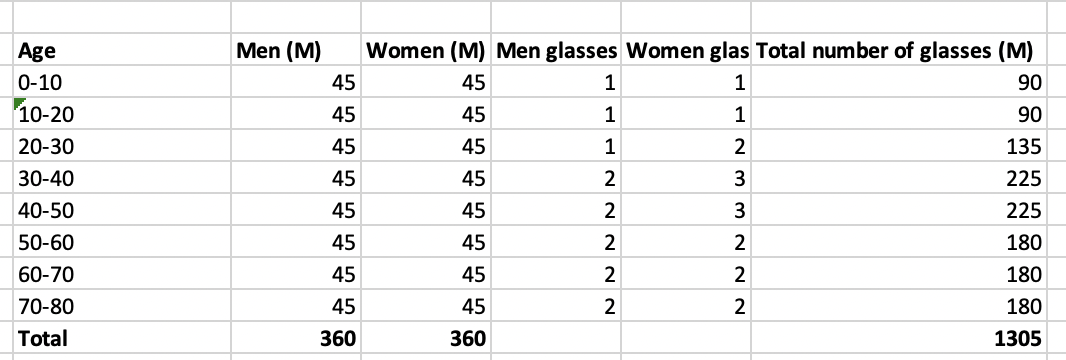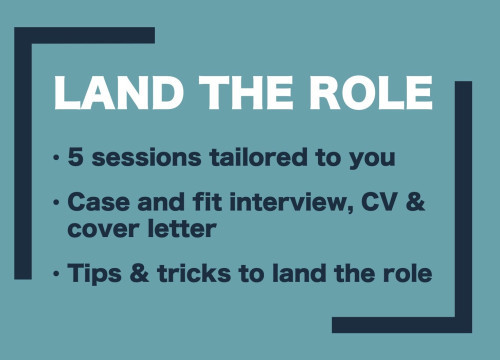Hi!
How would you answer this market sizing question :
Estimate the European sunglasses market.
Thanks!
Hi!
How would you answer this market sizing question :
Estimate the European sunglasses market.
Thanks!


This is so fun!
Ok so I'd approach it as, first, identify whether we're talking about the number of sunglasses or the revenue. Assuming revenue I'd estimate:
1. What is the population of Europe? Around 750m
2. How does this breakdown by age and gender? I'd assume that it's 50% split men and women; that people live on average for 80 years; and that the population is evenly distributed by age (this is obviously not necessarily the case, and I'd ask the interviewer if they'd like any more detailed estimates). To make the maths easy I'd ask if I can assume there are 45m people in each age category.
3. You then have to assume how many sunglasses each group has. I'd say:
- 0-10: 1 pair each, boys and girls. Parents don't want to spend more than that
- 10-20: 1 pair each, boys and girls. Teenagers / young adults don't really have their own money.
- 20-30: 1 pair for men; 2 pairs for women. More disposable income, women tend to be more fashion conscious than men
- 30-40: 2 pairs men; 3 pairs women. Men start to lose their eyesight and so may need more glasses, or want to have sports glasses as well as ‘fashion’ glasses. Women have liked accumulated some over the years.
- 40-50 through to 70-80: I'd keep it as 2 pairs each. Women may have less income to spend on fashion.
4. I'd make a table which looks like this:

5. You think need to think about how often glasses are replaced. I'd estimate every five years. So you get half of 1,305M glasses every year in the market. I'd round this to 260M.
6. I'd then make an assumption on the average cost of sunglasses - $30. And multiple 650M glasses by $30 to get to $7.83B.
7. I'd then sense check it - that'd mean that everyone in Europe was spending $10 on sunglasses a year - I think that sounds about right.
Hope that helps!

This get's you a good estimation. Value add insights - typically on special groups:
I don't think any of the above really moves the needle, but would be something I would definitely consider in a detailed estimation in real life. [don't forget, cases are about what you would do in real life]

Hi Laura,
You'll learn a lot more from this by trying it out yourself first! Why don't you post your approach here and we can provide commentary?
How to approach market sizing
It's very simple: Do the approach the is the easiest for you given the question.
Are they asking you to estimate something where you don't even know where to begin from the top (maybe you have 0 clue as to the market size of the industry, the GDP of that country, etc. etc.)? Then do bottom-up!
Alternatively, does it seem impossible to do a realistic from-the-ground-up estimation of something (perhaps it requires just far too many steps and assumptions)? Then do top-down!
Fundamentally, you need to take the approach that just makes the most sense in that circumstance. Quickly think about the key assumptions / numbers required and whether you 1) Know them or 2) Can reasonably estimate them. If you can, go ahead!
An Example
He's a Q&A for a great market sizing question here asking to estimate # of electric charging stations in a city in 10 years:
This one could be answered top-down (as I did) by estimating population of the city, # of drivers/ cars, etc. etc.
OR, it could be answered bottom-up by estimating # of stations you see per block (or # of gas/petrol tanks), % increase this might be over time (or # of EV stations that would be needed per gas tank given EV stations take 10 times as long), and # of blocks you'd estimate the city to have.
Take a look here for additional practice! https://www.preplounge.com/en/management-consulting-cases/brain-teaser/intermediate/taxis-in-manhattan-market-sizing-229

Hi Laura, I would recommend to propose a sample approach in your question and then we can provide you guidance based on it. This will help you better.











